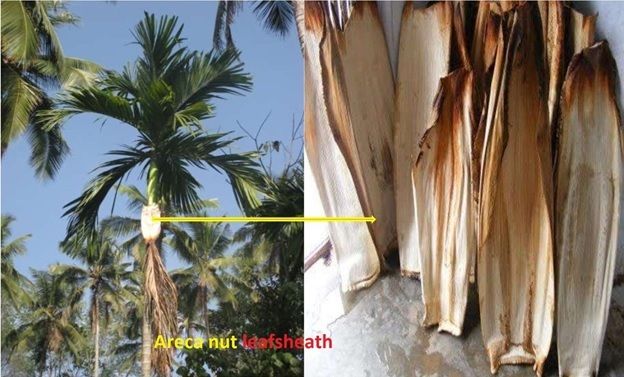India is the highest producer of areca nut in the world - the country accounts for more than 50 per cent of world production. The leaf sheath of areca nut consists of many constituent materials like cellulose, hemicellulose, lignin and pectin etc. Long staple fibres can be extracted from areca nut leaf sheath by alkali treatment. A report.
Areca catechu or areca palm is a species of palm family. It is commonly grown in the tropical regions. Areca nut is an important cash crop which is grown in India, China, Malaysia, Taiwan, and other Asian countries mainly for their seeds-nuts. India is the highest producer of areca nut in the world - accounts for more than 50 per cent of world production. It is estimated that every year India produces l000 million areca nut leaf sheaths weighing around 2.33 lakh tonnes. Leaf sheath of areca palm is a hard biodegradable fibrous material. It is easily available, low-priced and renewable resource of lignocellulosic agricultural biomass. The leaf sheath consists of many constituent materials like cellulose, hemicellulose, lignin and pectin etc. Long staple fibres can be extracted from areca nut leaf sheath by alkali treatment.

Fibre Properties
Chemical composition of fibre
Being lignocellulosic fibre, areca nut leaf sheath fibre contains three basic chemical components, that is, cellulose, hemicelluloses and lignin. It is observed that areca nut leaf sheath fibre contains 56.8 per cent cellulose, 22.4 per cent hemicelluloses and 6.3 per cent lignin, respectively.
Crystallinity index and microfibrillar angle
It is demonstrated that strength and initial modulus of lignocellulosic fibres depend on the crystallinity index and microfibril angle. Higher crystallinity index and lower microfibril angle increase the mechanical properties of cellulosic fibres. It is observed that the crystallinity index and microfibrillar angle of areca nut leaf sheath fibre are 56.5 per cent and 35.2o, respectively.
Moisture content of fibre
Being natural fibre areca nut leaf sheath fibre contains hydrophilic -OH group in their molecules. The water molecules present in atmosphere attract to hydrophilic groups of fibre and form hydrogen bonds. It is observed that moisture content of areca nut leaf sheath fibre is 11.9 per cent.
Fibre length and diameter:
Length and diameter of a fibre is an important parameter to control the quality of fibre. Use area, processing performance and textile properties etc are affected by the length and diameter of fibre. Areca nut leaf sheath length is around 1-1.5m long. The individual fibres lie continuously along the length of sheath. The extracted fibre length depends on the chopped length of areca nut leaf sheath during fibre extraction process. The maximum fibre length will be the same length of leaf sheath. It is observed that the fibre diameter varies from 14 to 392 µm with an average diameter of 55 µm.
Bundle and single fibre strength
One of the most important properties of fibre is the tensile property. Tensile properties of yarns and fabrics depend on both complex fibre arrangements inside the yarn and fabric structure, and also on the tensile properties of fibres. The bundle strength of areca nut leaf sheath fibre is 18.8 g/tex at 5 cm gauge length. The single fibre tensile strength, initial modulus and elongation at break are 400 MPa, 11.8 GPa and 8 per cent, respectively.
Table.1 Areca nut leaf sheath fibre properties and its comparison with other cellulosic fibres.

Conclusion
The cellulose content and crystallinity index of areca nut leaf sheath fibre is around 56.8 per cent and 56.5 per cent, respectively, which is comparable to commonly available lignocellulosic fibres such as cornhusk, jute, coir etc. The fibre diameter is 54.8 µm, which is comparable with commonly available natural fibres. The overall fibre properties of fibre recommended that the fibre may be useful for textile, reinforcement in polymer composites and pulp and paper making application purposes.







Comments